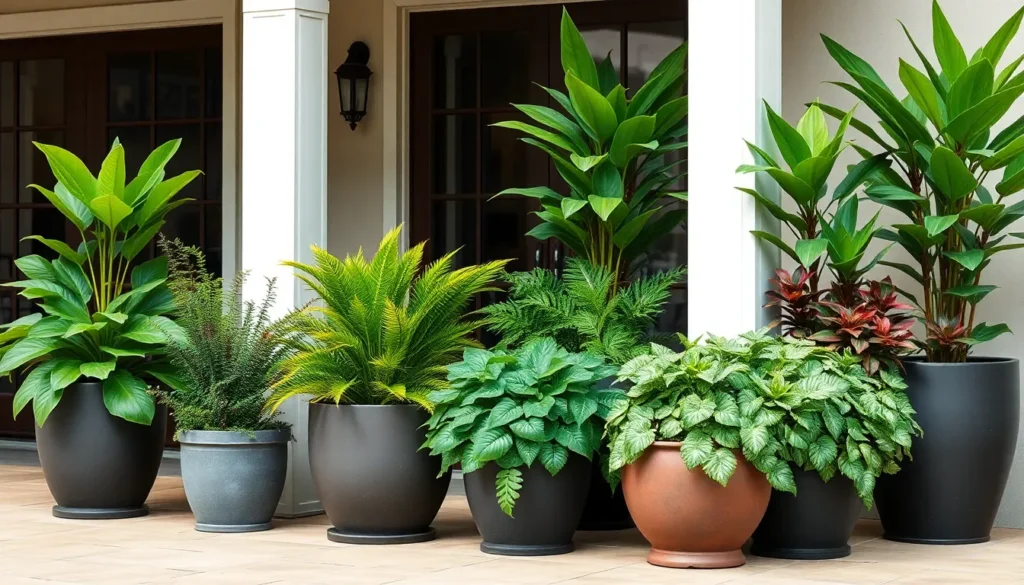Tired of watching your outdoor plants wither away even though your best efforts? We’ve all been there – investing time and money into beautiful outdoor planters only to see our green dreams turn brown and brittle. The constant watering, fertilizing, and worrying about weather conditions can turn gardening from a joy into a chore.
Faux plants for outdoor planters offer the perfect solution for busy homeowners who crave stunning curb appeal without the maintenance headaches. Today’s artificial plants are incredibly realistic, weather-resistant, and designed to fool even the most discerning eye. From lush tropical palms to vibrant flowering arrangements, these synthetic beauties deliver year-round color and texture.
We’ll explore everything you need to know about choosing, styling, and maintaining artificial plants in outdoor planters. Whether you’re dealing with challenging growing conditions, frequent travel, or simply want gorgeous greenery without the guesswork, faux plants might be your industry’s best-kept secret.
Choose Weather-Resistant Materials for Long-Lasting Beauty
Selecting the right materials ensures your faux outdoor planters maintain their stunning appearance through harsh weather conditions. We’ll explore the key features that separate premium artificial plants from cheaper alternatives.
UV-Protected Synthetic Foliage
UV protection stands as the most critical feature for outdoor artificial plants. Premium synthetic foliage incorporates specialized UV inhibitors directly into the material during manufacturing, preventing the sun’s rays from breaking down the polymers.
Look for plants labeled with UV resistance ratings of 2,000+ hours or more. These ratings indicate how long the material can withstand direct sunlight exposure before showing signs of degradation.
Quality manufacturers use advanced polymer blends like polyethylene and polypropylene that naturally resist UV damage. Some premium options feature multi layer construction with UV blocking additives in both the core material and surface coating.
Fade-Resistant Color Technology
Color retention technology determines whether your faux plants look vibrant or washed out after months outdoors. Modern artificial plants use solution dyed materials where pigments are integrated throughout the entire fiber rather than applied as surface treatments.
Infrared reflective pigments help maintain true to life colors by bouncing heat away from the plant material. This technology prevents the thermal degradation that causes traditional dyes to fade or shift color over time.
We recommend checking for color fastness certifications from independent testing laboratories. Plants with Grade 4 or 5 color fastness ratings maintain their original appearance for 3 to 5 years in full sun conditions.
Waterproof Construction Features
Waterproof construction prevents moisture related damage that can destroy artificial plants from the inside out. Quality outdoor faux plants feature sealed stem connections and drainage friendly designs that allow water to flow through without pooling.
Marine grade materials resist mold and mildew growth even in humid climates. These specialized plastics won’t absorb water or develop the musty odors associated with moisture trapped artificial greenery.
Reinforced mounting systems use stainless steel hardware and weatherproof adhesives to maintain structural integrity. The best options include antimicrobial treatments that actively prevent bacterial and fungal growth on plant surfaces.
Select Realistic Textures and Natural Appearances
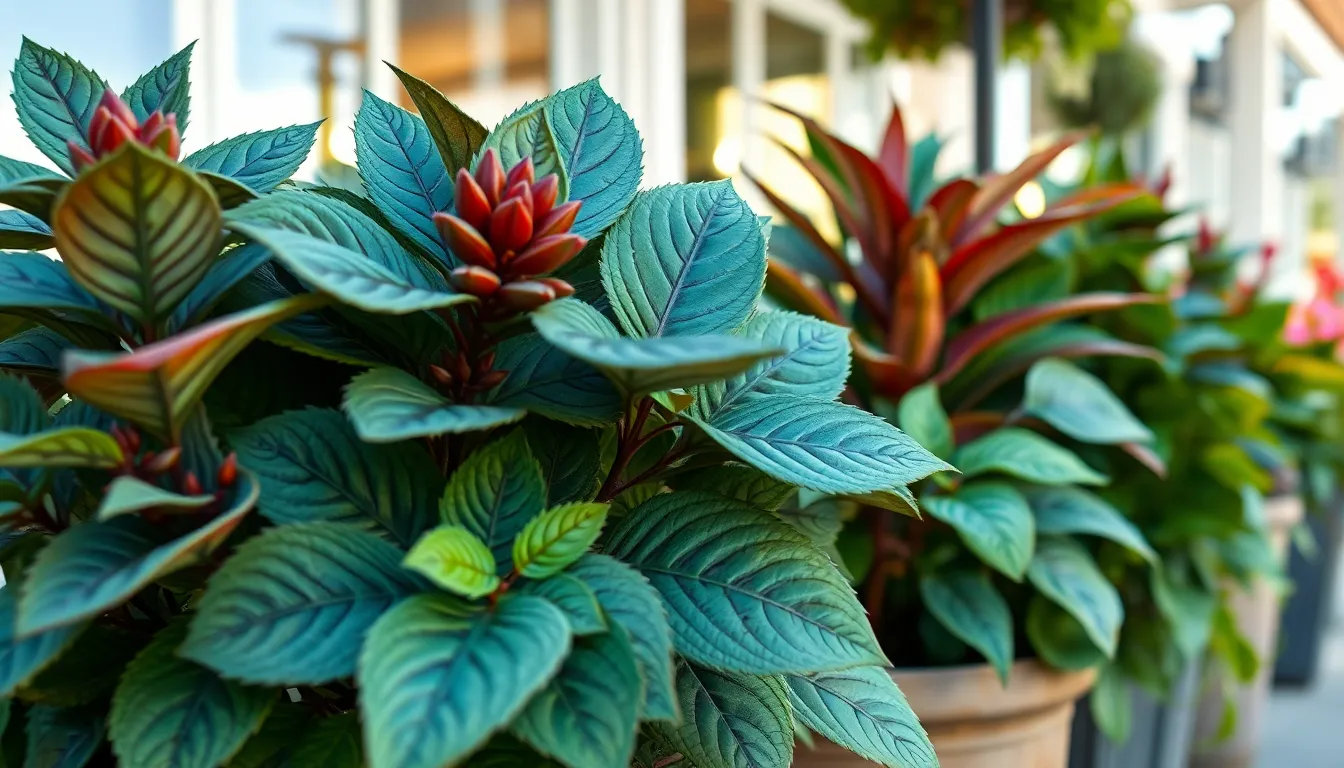
Once you’ve secured weather-resistant materials, the next crucial step involves focusing on visual authenticity to create convincing outdoor displays.
High-Definition Leaf Details
Examine leaf venation patterns closely when selecting outdoor faux plants, as premium artificial foliage features intricate vein structures that mirror real plant biology. Quality synthetic leaves showcase detailed surface textures with raised veins, natural irregularities, and subtle variations in thickness that catch light similarly to living plants.
Choose plants with varied leaf shapes within each stem arrangement, since nature rarely produces perfectly uniform foliage. Top-tier artificial plants incorporate multiple leaf sizes, slight asymmetries, and occasional imperfections that enhance their believability.
Verify UV-resistant leaf materials maintain their detailed textures over time, as cheaper alternatives often lose definition when exposed to sunlight. Brands like Enduraleaf specifically engineer their leaf details to withstand weather exposure while preserving realistic surface characteristics.
Authentic Bark and Stem Textures
Select stems with rough, irregular textures that replicate the natural bark patterns found on real trees and shrubs. Premium artificial plants feature stems with realistic color variations, natural grooves, and surface imperfections that make them virtually indistinguishable from genuine wood.
Look for varying trunk diameters within plant arrangements, as nature creates trees with tapered trunks and branches of different thicknesses. Quality faux plants incorporate these natural proportions with authentic bark coloration ranging from deep browns to subtle grays.
Ensure stem materials resist cracking under temperature fluctuations, since outdoor conditions can cause inferior artificial bark to split or peel. Durable synthetic stems maintain their texture integrity through seasonal weather changes without losing their realistic appearance.
Natural Color Variations
Prioritize plants with subtle color gradations rather than uniform hues across all leaves, as real plants display natural variations in green tones from new growth to mature foliage. Premium artificial plants incorporate multiple shades within individual leaves and across entire arrangements.
Avoid overly vibrant or plastic-looking colors that immediately signal artificial origins, instead choosing plants with muted, natural tones that reflect seasonal changes. Quality synthetic foliage includes subtle yellowing on older leaves and brighter greens on newer growth areas.
Select color-retention technology that prevents fading while maintaining natural-looking variations, ensuring your outdoor arrangements stay realistic throughout the year. Pottery Pots and similar premium brands engineer their color systems to preserve authentic plant tones even though continuous sun exposure.
Consider Size and Scale for Your Outdoor Space
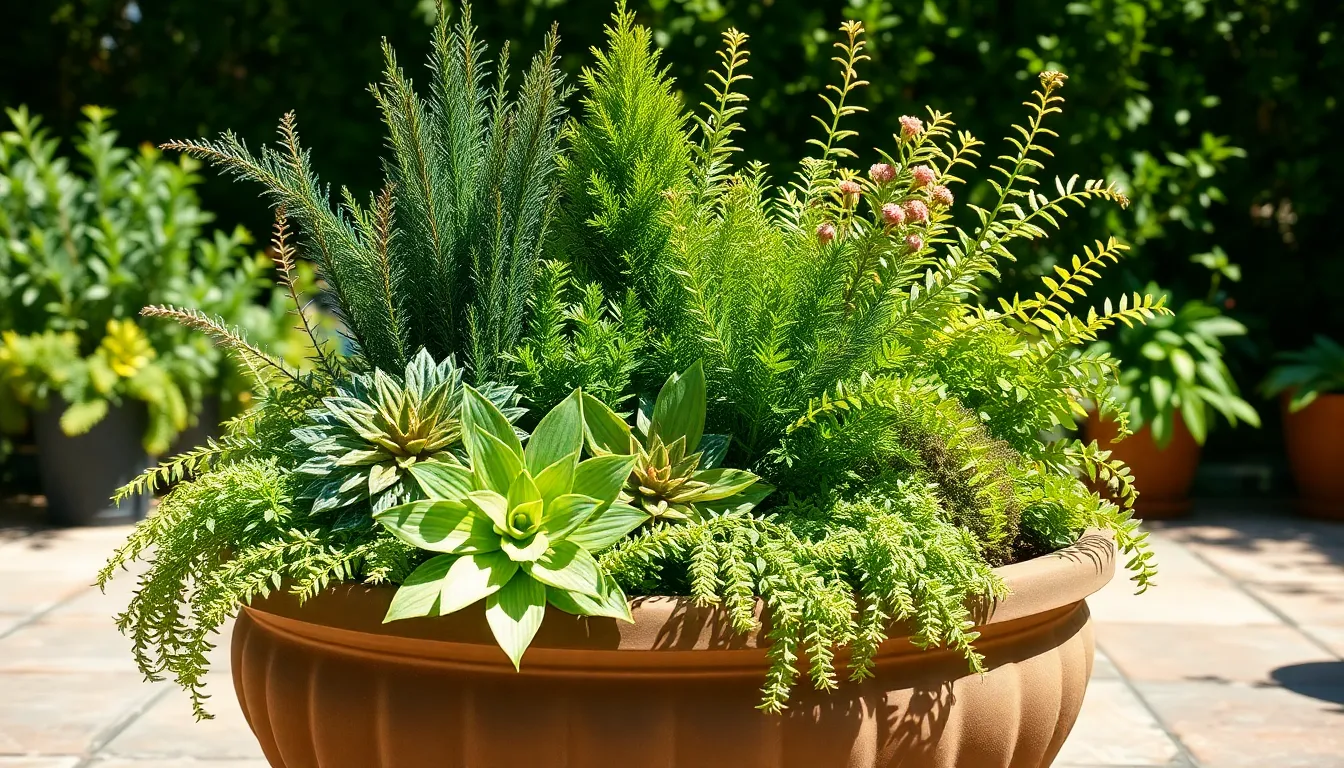
Getting the proportions right makes all the difference when selecting faux plants for outdoor planters. We’ll help you achieve perfectly balanced arrangements that complement your space.
Matching Plant Height to Planter Dimensions
Choose faux plants whose height complements your planter size for optimal visual impact. Tall synthetic plants work best in large, deep containers where they maintain proper proportion. We recommend pairing 3-foot artificial plants with planters that are at least 18 inches deep and wide. Shorter faux varieties suit smaller containers perfectly, preventing awkward imbalances that can make your outdoor space look cramped. Small 12-inch synthetic plants pair beautifully with compact 8-inch planters for tabletop displays.
Measure your planter dimensions before shopping to ensure you select appropriately sized artificial plants. Deep planters accommodate root-like bases that come with premium faux plants, while shallow containers work better with plants that have minimal base structures. We’ve found that maintaining a 2:1 or 3:1 height ratio between plant and planter creates the most natural appearance.
Creating Balanced Visual Proportions
Balance plant height, width, and fullness with your planter’s shape and surrounding outdoor environment. Wide, bushy artificial plants complement rectangular planters beautifully, while narrow, upright synthetic varieties suit cylindrical containers. We avoid placing oversized faux plants in small planters as this creates visual tension and makes spaces feel cluttered.
Consider the scale of your outdoor area when selecting artificial plant sizes. Large patios can handle substantial faux arrangements with multiple tall plants, while intimate balconies benefit from smaller, more delicate synthetic displays. We recommend stepping back frequently during arrangement to assess overall proportions from different viewing angles.
Account for seasonal viewing distances when planning your faux plant proportions. Plants viewed from across a yard need different scaling than those positioned near seating areas where details matter more. We suggest using larger artificial plants for distant viewing and reserving detailed, smaller synthetic varieties for close-up appreciation.
Layering Different Plant Sizes
Combine faux plants of varying heights and textures to create natural-looking depth and visual interest. Place taller artificial plants at the back or center of arrangements, then surround them with medium-height synthetic varieties. We finish with smaller faux plants around the edges to create a cascading effect that mimics natural garden growth patterns.
Layer artificial plants using the “thriller, filler, spiller” technique for professional results. Choose one tall “thriller” faux plant as your focal point, add medium-sized “filler” synthetic plants for body, and include trailing “spiller” artificial varieties that drape over planter edges. We’ve found this three-tier approach creates the most ever-changing and realistic outdoor arrangements.
Vary textures and leaf shapes within your layered faux plant arrangements. Mix broad-leafed artificial plants with fine, needle-like synthetic varieties to add contrast and visual complexity. We recommend including at least three different texture types in larger planters to achieve that natural, garden-grown appearance that makes artificial plants virtually indistinguishable from real ones.
Pick Low-Maintenance Options That Save Time
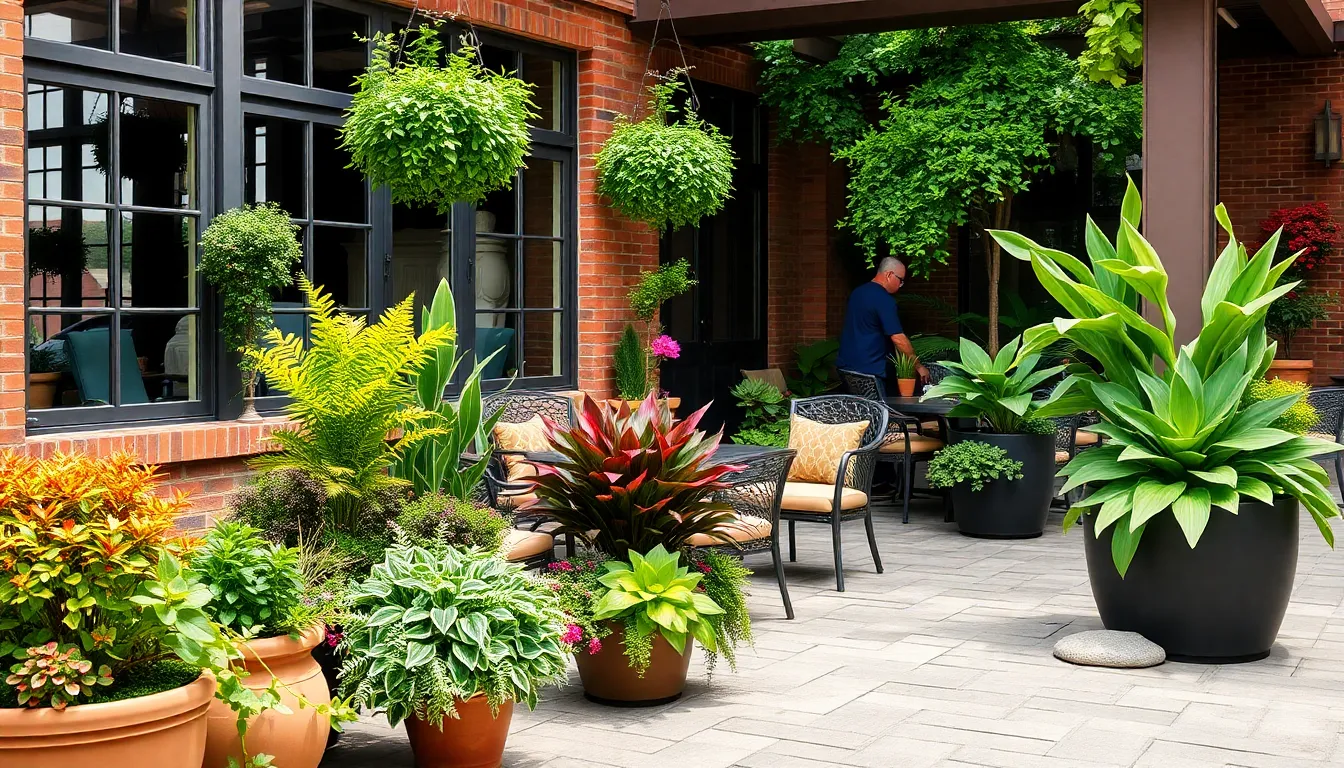
Selecting faux plants for outdoor planters eliminates the daily care routines that real plants demand. We’ll explore how artificial plants transform your outdoor spaces into beautiful areas without the ongoing maintenance burden.
No Watering or Fertilizing Required
Artificial plants operate completely independently from soil nutrients and watering schedules. We never need to worry about drought conditions or forgotten watering sessions that can kill expensive live plants.
Fertilizing becomes obsolete with synthetic foliage since these plants don’t require soil amendments or seasonal feeding programs. Water conservation efforts benefit significantly from faux plant installations, especially in drought-prone regions where watering restrictions limit traditional gardening.
Resource allocation shifts dramatically when we choose artificial plants for our outdoor planters. Time previously spent on watering routines can focus on other landscaping projects or personal activities. Our water bills reflect immediate savings since outdoor plant watering typically accounts for substantial household water usage during growing seasons.
Pest and Disease Resistance
Synthetic plants resist all forms of pest damage that commonly destroy live outdoor plantings. We eliminate concerns about aphids, spider mites, scale insects, and other harmful pests that attack traditional garden plants.
Disease prevention becomes automatic with artificial foliage since fungal infections, bacterial diseases, and viral problems cannot affect synthetic materials. Root rot, powdery mildew, and leaf spot diseases never threaten our faux plant investments.
Wildlife damage disappears when we install quality artificial plants in outdoor planters. Deer, rabbits, birds, and other animals show no interest in synthetic foliage, preserving our landscaping investment year after year. Pet damage also becomes irrelevant since dogs and cats cannot dig up or destroy artificial plant installations.
Year-Round Consistent Appearance
Faux plants maintain their vibrant colors and realistic textures through every season without seasonal decline. We enjoy consistent lush greenery during winter months when live plants typically go dormant or die back completely.
Weather resistance ensures our artificial plants look fresh and attractive regardless of rain, snow, extreme heat, or freezing temperatures. Seasonal replanting becomes unnecessary since quality synthetic plants retain their appearance for multiple years with minimal care.
Color retention technology in premium artificial plants prevents fading from UV exposure and harsh weather conditions. We avoid the seasonal brown-out periods that affect many live plants during stress periods like drought, extreme temperatures, or seasonal transitions.
Focus on Seasonal Versatility for Year-Round Appeal
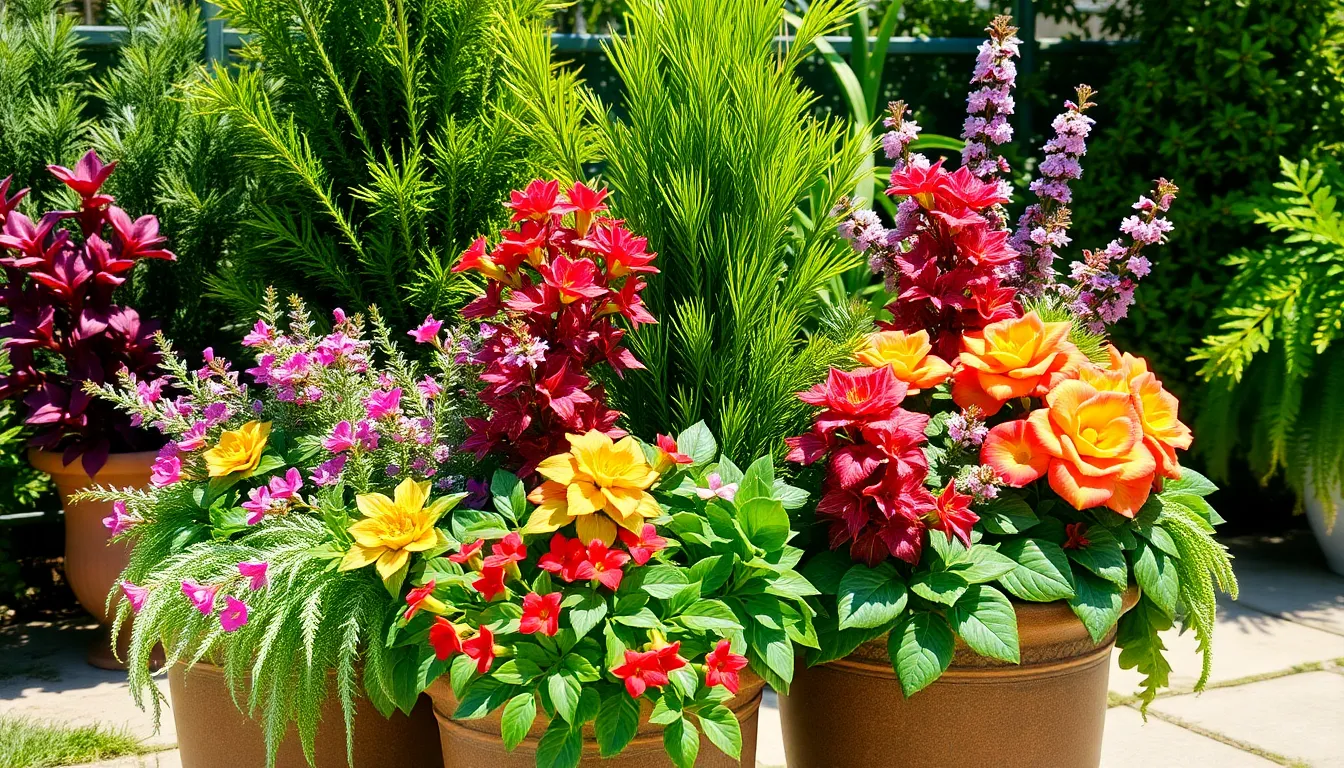
Seasonal changes present unique challenges for outdoor plant displays, but artificial plants eliminate these concerns entirely. Unlike real plants that struggle through harsh winters or scorching summers, premium faux plants maintain their vibrant appearance throughout all seasons.
Plants That Look Great in All Weather
Artificial tropical plants like palm trees and Cycas create a lush summer atmosphere regardless of your local climate conditions. These synthetic varieties resist wilting and fading while providing continuous enjoyment of greenery even during winter months when real plants die back. Faux bushes such as realistic Cypress bushes offer a polished, consistent look through all seasons without requiring the extensive upkeep that real bushes demand.
Weather resistant artificial garden plants feature UV protection and water resistance that enhance their durability outdoors. Premium synthetic foliage incorporates specialized UV inhibitors that prevent color degradation from intense sunlight exposure. Hanging plants provide diverse options to add color and texture in any weather, with many products specifically engineered to withstand various weather conditions while maintaining their lifelike appearance.
Mixing Evergreen and Flowering Varieties
Combining evergreen faux plants with flowering varieties creates ever-changing visual interest throughout the year. The evergreen selections provide constant greenery that serves as a reliable backdrop for seasonal color changes. Flowering faux plants add bursts of vibrant color and can be easily swapped to reflect different seasonal decor themes without the hassle of replanting.
Strategic placement of both plant types supports a maintenance free display that adapts to your changing aesthetic preferences. Evergreen varieties anchor your arrangement with consistent texture and form while flowering plants introduce seasonal variation. This combination strategy allows you to maintain visual appeal while eliminating the unpredictability associated with real plant care.
Adapting to Seasonal Decor Changes
Faux outdoor plants integrate seamlessly with seasonal decorative elements throughout the year. Their durability supports flexibility in styling since they don’t require replacement or maintenance tied to exact growing seasons. Holiday decorations such as lights, ribbons, or themed ornaments can be easily incorporated to reflect seasonal changes without damaging the plants.
Artificial plants resist pests and don’t require exact soil or sunlight conditions, making them practical choices for year round outdoor use. Weather resistant construction enables you to enhance displays with decorative accessories that complement different seasons. Synthetic foliage maintains its structural integrity while supporting additional decorative weight from seasonal embellishments like garlands or ornamental features.
Ensure Proper Drainage and Planter Preparation
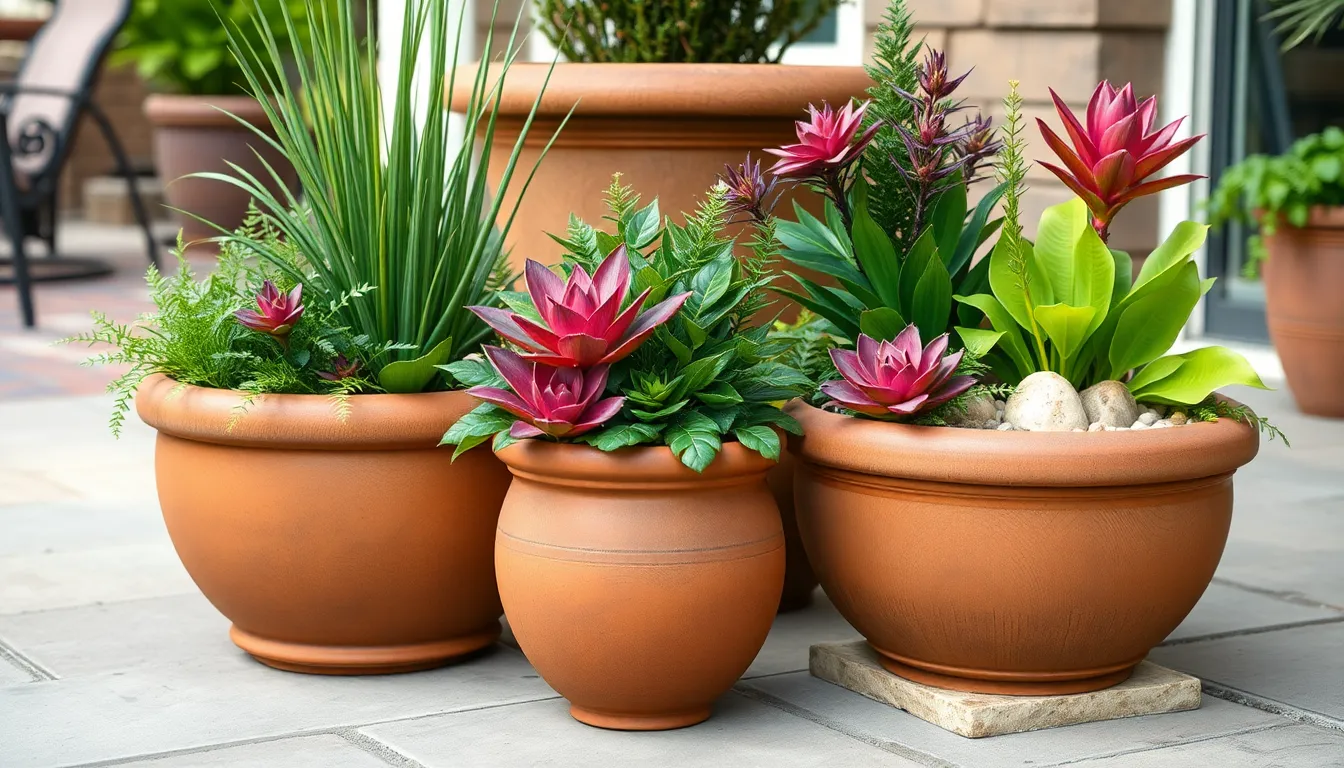
Even with artificial plants, proper drainage and planter setup remain crucial for protecting your containers and surrounding surfaces. We’ll walk you through the essential steps to create a stable foundation that’ll keep your faux outdoor arrangements looking pristine for years.
Adding Drainage Materials
Gravel or sand layers prevent moisture accumulation at the bottom of your planters, protecting both the container and underlying surfaces from water damage. We recommend adding a 2-3 inch layer of drainage material before placing your artificial plants. Coarse gravel works exceptionally well for larger planters, while fine sand suits smaller containers perfectly.
Natural soil can be layered on top of the drainage materials to anchor your faux plants and enhance the overall aesthetic appeal. This combination creates a realistic foundation that mimics traditional planting methods. Moisture won’t pool at the bottom when you have proper drainage layers in place, extending your planter’s lifespan significantly.
Securing Plants in Windy Conditions
Floral foam serves as an excellent anchor point for keeping artificial plant stems upright during strong winds. We insert the foam block into the center of the planter, then push plant stems directly into it for maximum stability. Chicken wire balls offer another effective anchoring solution, especially for arrangements with multiple stems.
Weatherproof adhesives provide additional security in areas prone to high winds or severe weather conditions. Silicone sealant works particularly well for permanent installations, while zip ties offer a removable option for seasonal arrangements. We always test the adhesive on a small area first to ensure compatibility with your exact planter material.
Layering techniques create both stability and visual appeal by starting with the tallest stems first, then filling around them with smaller plants. This method distributes weight evenly throughout the arrangement while creating natural-looking fullness. Multiple anchor points throughout the planter prevent individual plants from shifting or falling over during storms.
Protecting Planter Bottoms
Heavy containers significantly reduce the risk of tipping during windy conditions or accidental bumps. We recommend choosing planters made from concrete, ceramic, or thick plastic rather than lightweight materials. Adding stones or sand to the bottom provides extra weight while serving as drainage material.
Protective barriers between drainage layers and planter bottoms prevent scratching and moisture damage over time. Industry fabric or mesh screens work excellently for this purpose, allowing water to drain while keeping materials separated. This simple step can double or triple your planter’s usable lifespan, especially with natural materials like terracotta or wood.
Strategic placement on stable surfaces ensures your planters won’t shift or slide during maintenance or weather events. We suggest using rubber mats or furniture pads underneath containers placed on smooth surfaces like decks or patios. Grouping multiple planters together also creates stability through shared weight distribution and wind resistance.
Create Stunning Arrangements with Layered Plantings
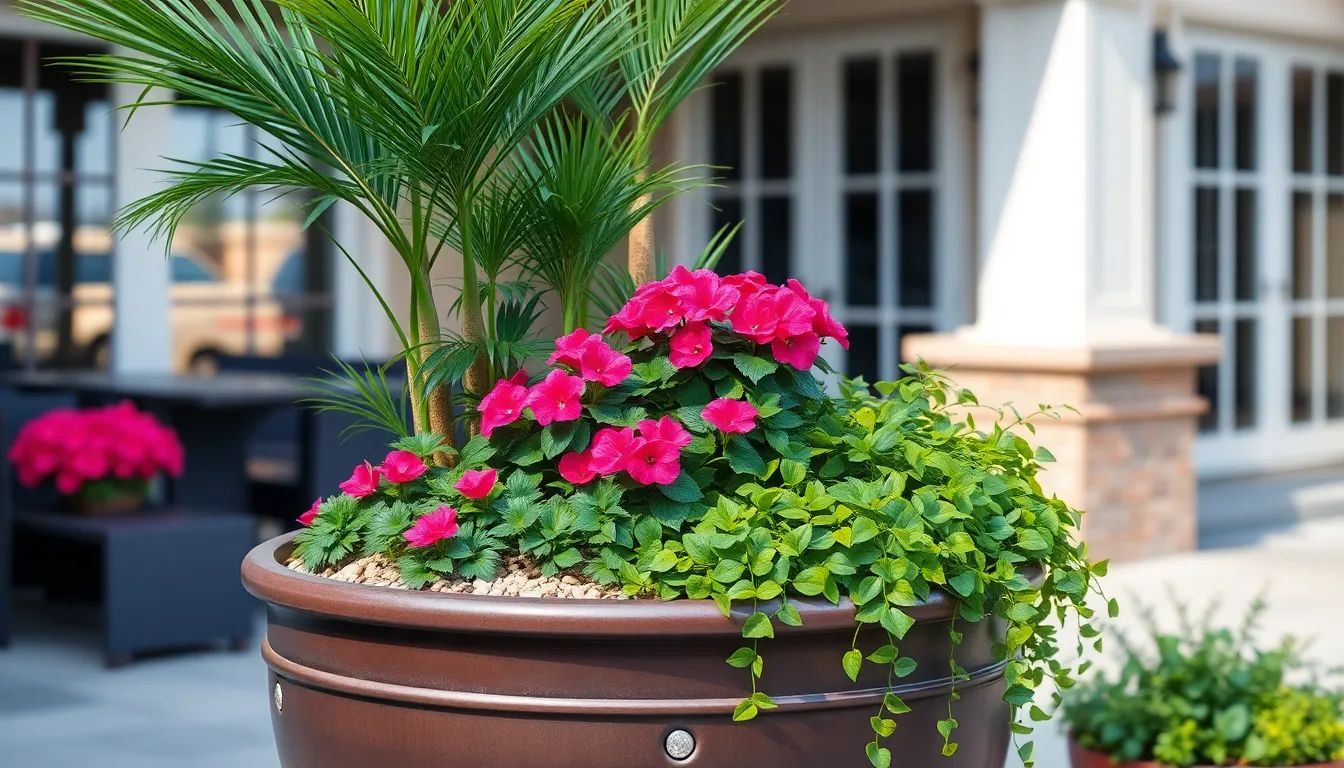
Layering transforms ordinary faux plant displays into sophisticated outdoor arrangements that mimic natural garden growth patterns. We’ll show you how strategic placement of different plant heights creates depth and visual interest that rivals living landscapes.
Combining Different Faux Plant Types
Mixing various artificial plant categories adds texture and color contrast that makes outdoor planters visually compelling. We recommend blending tall structural elements like artificial palm trees or ornamental grasses with medium height flowering plants such as faux geraniums or vibrant blooms. Cascading varieties like trailing ivy or hanging petunias work perfectly at planter edges to soften harsh transitions.
Different plant types serve exact purposes in layered arrangements. Flowering faux plants provide seasonal color bursts, while evergreen foliage offers year-round structure and stability. Textural plants like ferns or hostas fill middle spaces and add lush greenery that complements bolder flowering specimens.
UV-resistant artificial plants maintain their vibrant appearance when exposed to direct sunlight throughout growing seasons. Weather-resistant features ensure that mixed plant arrangements retain their realistic textures and colors regardless of outdoor conditions. Quality synthetic foliage incorporates fade-resistant technology that keeps arrangements looking fresh season after season.
Using Filler Plants and Greenery
Filler plants eliminate empty spaces while maintaining natural proportions in outdoor planters. Boston ferns, boxwood balls, and trailing ivy serve as versatile background elements that enhance featured plants without competing for attention. These foundational pieces create volume and density that makes arrangements appear fully established.
Strategic filler placement prevents planters from looking sparse or artificially constructed. We position medium-density greenery between taller backdrop plants and shorter accent pieces to create smooth transitions. Small leaf varieties like artificial eucalyptus or baby’s breath work exceptionally well for filling narrow gaps around larger specimens.
Green filler plants provide neutral backdrops that make colorful flowering varieties pop visually. Natural-looking moss or ground cover plants can carpet planter surfaces to conceal artificial stems and create realistic growing environments. Multiple filler textures prevent monotonous appearances while maintaining cohesive color schemes throughout the arrangement.
Adding Decorative Elements
Decorative accessories transform basic faux plant arrangements into polished outdoor focal points. Coordinated stones, colored mulch, or decorative pebbles create natural-looking surfaces while hiding artificial plant bases. Small garden statues or ornamental features add personality and visual anchors that complement plant selections.
Matching planter accessories like coordinated urns or statement wreaths near arrangements amplify overall design themes. We suggest incorporating seasonal decorative elements that can be easily swapped throughout the year while maintaining core plant arrangements. Natural materials like driftwood or river rocks add organic textures that enhance artificial plant realism.
Strategic lighting elements like solar stake lights or subtle LED accents highlight key plants during evening hours. Decorative elements should complement rather than overwhelm plant arrangements, maintaining focus on the layered botanical display. Quality accessories extend the visual impact of faux plant investments while requiring minimal ongoing maintenance.
Maintain Your Faux Plants for Optimal Longevity
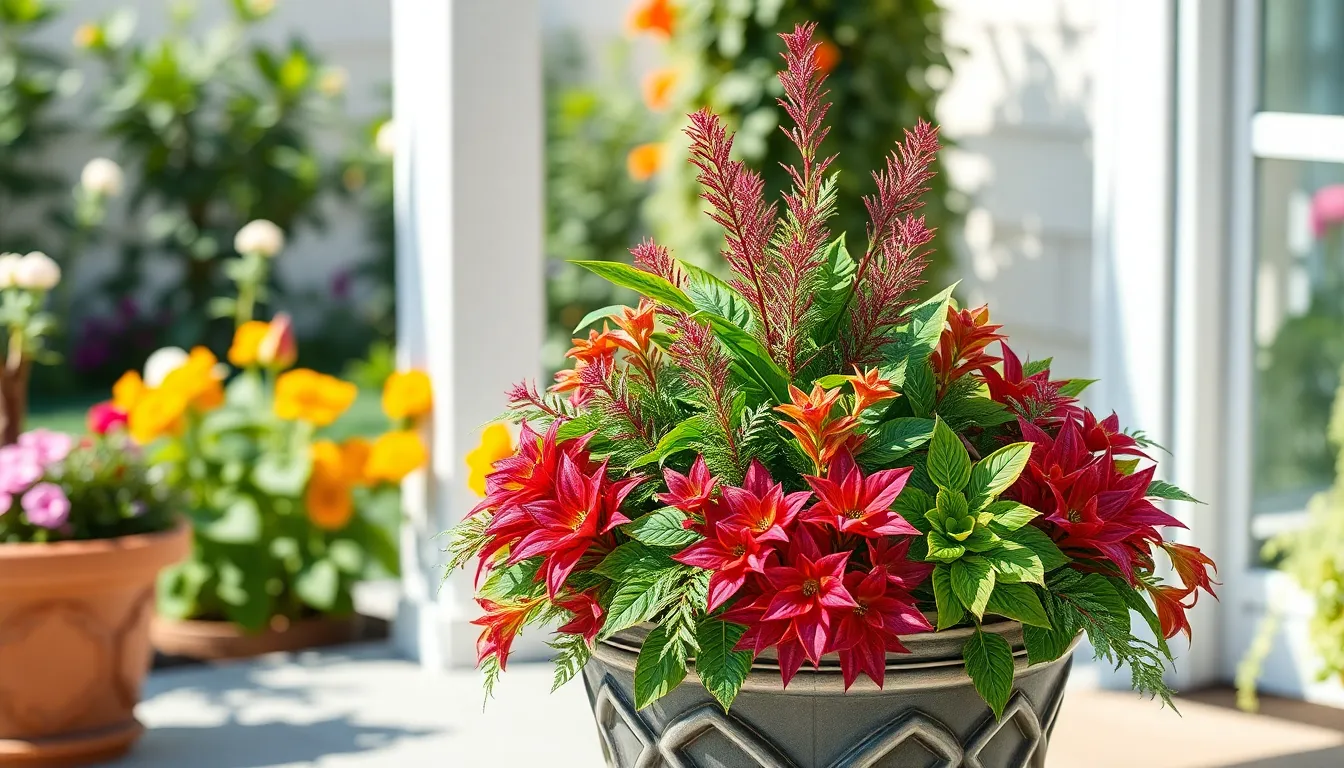
Proper maintenance extends the lifespan of your outdoor faux plants significantly, ensuring they continue to provide stunning visual appeal for years. We’ll show you proven techniques to keep your artificial foliage looking fresh and vibrant through every season.
Regular Cleaning Techniques
Dusting becomes essential for maintaining the realistic appearance of your faux plants throughout the growing season. We recommend using a soft cloth or feather duster weekly to remove accumulated dirt and debris from leaves and stems. This simple practice prevents buildup that can dull the natural colors of your artificial foliage.
Water spraying offers an effective method for deeper cleaning without causing damage to your synthetic plants. Set your garden hose to a low pressure setting and gently rinse away stubborn dirt particles. This technique works particularly well for larger arrangements where individual leaf cleaning isn’t practical.
Power washing provides the most thorough cleaning option for end of season maintenance. We suggest using soap and water with your pressure washer on a gentle setting to remove embedded grime and restore the original luster of your faux plants. This intensive cleaning method prepares your artificial greenery for storage or continued outdoor display.
Seasonal Storage Tips
Proper storage protects your investment in quality faux plants during harsh winter months or extended periods of non use. We recommend moving your artificial arrangements to a dry, temperature controlled area such as a garage or basement to prevent moisture damage and extreme temperature fluctuations.
UV protection becomes crucial when storing faux plants that have been exposed to direct sunlight throughout the season. Consider using UV resistant storage bags or covers to prevent additional color fading during the storage period. This extra step helps maintain the vibrant appearance of your synthetic foliage for the following year.
Climate control ensures your stored faux plants remain in optimal condition until their next outdoor placement. Avoid areas with high humidity or dramatic temperature swings, as these conditions can affect the structural integrity of artificial materials over time.
Touch-Up and Repair Methods
Color touch up restores faded areas of your faux plants using fabric paint or specialized touch up sprays designed specifically for artificial vegetation. We recommend testing any color matching products on a hidden area first to ensure proper color coordination with your existing plant materials.
Repairing damage extends the usable life of your faux plants when leaves or stems become loose or broken. Plant repair kits containing specialized adhesives work effectively for most common issues. Hot glue provides an alternative solution for securing detached elements quickly and permanently.
Replacement parts offer another maintenance option when individual components of your faux arrangements become too damaged to repair effectively. Many manufacturers provide replacement leaves, flowers, or stems that match their original products, allowing you to refresh exact areas without replacing entire plants.
Conclusion
We’ve explored how faux plants can transform your outdoor spaces into stunning displays that require minimal effort while delivering maximum impact. With proper selection and arrangement techniques you’ll create beautiful planters that withstand any weather condition.
The investment in quality artificial plants pays off through years of consistent beauty without the ongoing costs of replacement or intensive care. Whether you’re dealing with challenging growing conditions or simply want more time to enjoy your outdoor space rather than maintaining it these synthetic alternatives offer the perfect solution.
Your outdoor planters can now showcase vibrant greenery year-round while you focus on what matters most to you.
Frequently Asked Questions
What are the main benefits of using faux plants for outdoor planters?
Faux plants offer year-round beauty without the hassle of watering, fertilizing, or pest control. They’re weather-resistant, maintain vibrant colors in all seasons, and eliminate concerns about plant diseases or wildlife damage. Perfect for drought-prone areas, they save time and water while providing consistent visual appeal regardless of growing conditions.
How do I choose weather-resistant artificial plants for outdoor use?
Look for plants with UV protection, fade-resistant color technology, and waterproof construction. Premium synthetic foliage incorporates UV inhibitors to withstand sunlight exposure, while color retention technology maintains vibrant hues. Waterproof materials prevent moisture damage, ensuring your faux plants remain intact and visually appealing in harsh weather conditions.
What makes artificial plants look realistic outdoors?
High-quality faux plants feature intricate leaf details with realistic vein structures, varied leaf shapes, and authentic bark textures. Look for natural color variations with subtle gradations rather than uniform hues. Premium artificial plants include natural imperfections and realistic color variations that mimic real plant characteristics for enhanced authenticity.
How do I determine the right size faux plants for my planters?
Match plant height to planter dimensions for optimal visual impact. Consider the planter’s shape and surrounding environment, avoiding oversized plants in small containers. Use the “thriller, filler, spiller” technique by layering different plant sizes and textures to create depth and balanced visual proportions in your arrangements.
Do faux plants require any maintenance for outdoor use?
While low-maintenance, faux plants benefit from regular dusting and occasional power washing to remove dirt and debris. Store them during extreme weather if possible, and perform touch-ups on faded areas as needed. Proper drainage preparation and securing methods help extend their lifespan and maintain their appearance.
How should I prepare planters for faux plant arrangements?
Create proper drainage by adding layers of gravel or sand to prevent moisture accumulation. Use floral foam, chicken wire, or weatherproof adhesives to secure plants in windy conditions. Ensure stable foundations and consider weight distribution to prevent tipping during storms while maintaining aesthetic appeal.
Can I mix different types of faux plants in one arrangement?
Yes, mixing various faux plant types adds texture and color contrast. Combine tall structural elements with medium-height flowering plants and cascading varieties. Strategic placement of different heights mimics natural growth patterns and creates visually appealing, layered arrangements that look professionally designed.
How long do quality faux plants last outdoors?
Premium weather-resistant faux plants can last several years outdoors with proper care. UV-protected materials and fade-resistant technologies help maintain appearance, while regular maintenance like cleaning and touch-ups extends their lifespan. Quality construction ensures durability against weather elements and seasonal changes.

